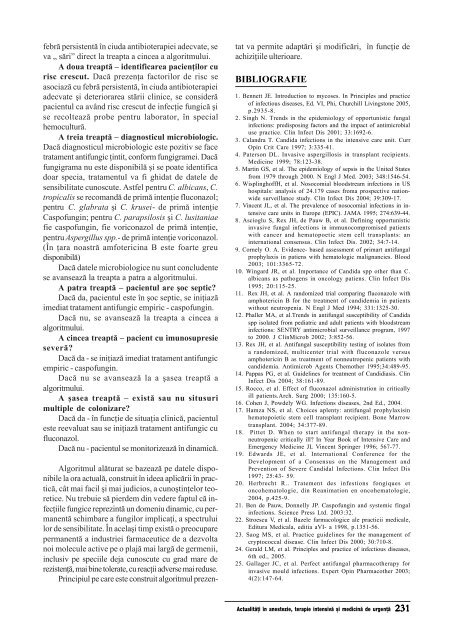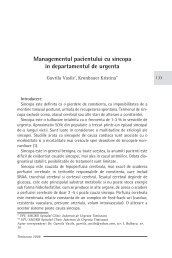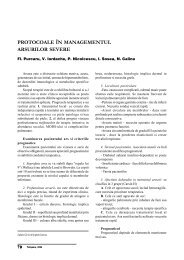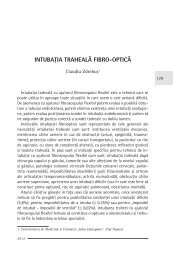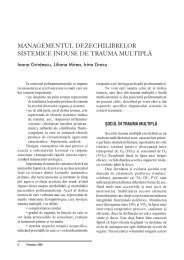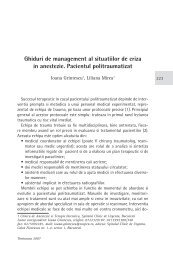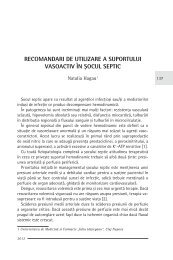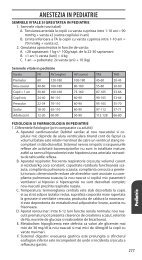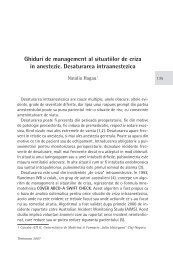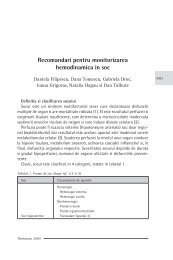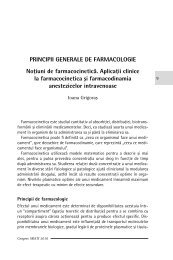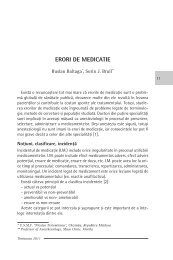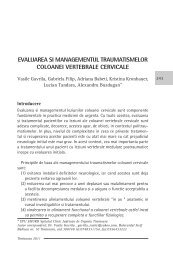Algoritm de diagnostic si tratament in infectiile fungice in
Algoritm de diagnostic si tratament in infectiile fungice in
Algoritm de diagnostic si tratament in infectiile fungice in
Create successful ePaper yourself
Turn your PDF publications into a flip-book with our unique Google optimized e-Paper software.
febră per<strong>si</strong>stentă în ciuda antibioterapiei a<strong>de</strong>cvate, se<br />
va „ sări” direct la treapta a c<strong>in</strong>cea a algoritmului.<br />
A doua treaptă – i<strong>de</strong>ntificarea pacienţilor cu<br />
risc crescut. Dacă prezenţa factorilor <strong>de</strong> risc se<br />
asociază cu febră per<strong>si</strong>stentă, în ciuda antibioterapiei<br />
a<strong>de</strong>cvate şi <strong>de</strong>teriorarea stării cl<strong>in</strong>ice, se con<strong>si</strong><strong>de</strong>ră<br />
pacientul ca având risc crescut <strong>de</strong> <strong>in</strong>fecţie fungică şi<br />
se recoltează probe pentru laborator, în special<br />
hemocultură.<br />
A treia treaptă – <strong>diagnostic</strong>ul microbiologic.<br />
Dacă <strong>diagnostic</strong>ul microbiologic este pozitiv se face<br />
<strong>tratament</strong> antifungic ţ<strong>in</strong>tit, conform fungigramei. Dacă<br />
fungigrama nu este disponibilă şi se poate i<strong>de</strong>ntifica<br />
doar specia, <strong>tratament</strong>ul va fi ghidat <strong>de</strong> datele <strong>de</strong><br />
sen<strong>si</strong>bilitate cunoscute. Astfel pentru C. albicans, C.<br />
tropicalis se recomandă <strong>de</strong> primă <strong>in</strong>tenţie fluconazol;<br />
pentru C. glabrata şi C. krusei- <strong>de</strong> primă <strong>in</strong>tenţie<br />
Caspofung<strong>in</strong>; pentru C. parap<strong>si</strong>lo<strong>si</strong>s şi C. lu<strong>si</strong>taniae<br />
fie caspofung<strong>in</strong>, fie voriconazol <strong>de</strong> primă <strong>in</strong>tenţie,<br />
pentru Aspergillus spp.- <strong>de</strong> primă <strong>in</strong>tenţie voriconazol.<br />
(În ţara noastră amfoteric<strong>in</strong>a B este foarte greu<br />
disponibilă)<br />
Dacă datele microbiologice nu sunt conclu<strong>de</strong>nte<br />
se avansează la treapta a patra a algoritmului.<br />
A patra treaptă – pacientul are şoc septic?<br />
Dacă da, pacientul este în şoc septic, se <strong>in</strong>iţiază<br />
imediat <strong>tratament</strong> antifungic empiric - caspofung<strong>in</strong>.<br />
Dacă nu, se avansează la treapta a c<strong>in</strong>cea a<br />
algoritmului.<br />
A c<strong>in</strong>cea treaptă – pacient cu imunosupre<strong>si</strong>e<br />
severă?<br />
Dacă da - se <strong>in</strong>iţiază imediat <strong>tratament</strong> antifungic<br />
empiric - caspofung<strong>in</strong>.<br />
Dacă nu se avansează la a şasea treaptă a<br />
algoritmului.<br />
A şasea treaptă – există sau nu <strong>si</strong>tusuri<br />
multiple <strong>de</strong> colonizare?<br />
Dacă da - în funcţie <strong>de</strong> <strong>si</strong>tuaţia cl<strong>in</strong>ică, pacientul<br />
este reevaluat sau se <strong>in</strong>iţiază <strong>tratament</strong> antifungic cu<br />
fluconazol.<br />
Dacă nu - pacientul se monitorizează în d<strong>in</strong>amică.<br />
<strong>Algoritm</strong>ul alăturat se bazează pe datele disponibile<br />
la ora actuală, construit în i<strong>de</strong>ea aplicării în practică,<br />
cât mai facil şi mai judicios, a cunoşt<strong>in</strong>ţelor teoretice.<br />
Nu trebuie să pier<strong>de</strong>m d<strong>in</strong> ve<strong>de</strong>re faptul că <strong>in</strong>fecţiile<br />
<strong>fungice</strong> reprez<strong>in</strong>tă un domeniu d<strong>in</strong>amic, cu permanentă<br />
schimbare a fungilor implicaţi, a spectrului<br />
lor <strong>de</strong> sen<strong>si</strong>bilitate. În acelaşi timp există o preocupare<br />
permanentă a <strong>in</strong>dustriei farmaceutice <strong>de</strong> a <strong>de</strong>zvolta<br />
noi molecule active pe o plajă mai largă <strong>de</strong> germenii,<br />
<strong>in</strong>clu<strong>si</strong>v pe speciile <strong>de</strong>ja cunoscute cu grad mare <strong>de</strong><br />
rezistenţă, mai b<strong>in</strong>e tolerate, cu reacţii adverse mai reduse.<br />
Pr<strong>in</strong>cipiul pe care este construit algoritmul prezentat<br />
va permite adaptări şi modificări, în funcţie <strong>de</strong><br />
achiziţiile ulterioare.<br />
BIBLIOGRAFIE<br />
1. Bennett JE. Introduction to mycoses. In Pr<strong>in</strong>ciples and practice<br />
of <strong>in</strong>fectious diseases, Ed. VI, Phi, Churchill Liv<strong>in</strong>gstone 2005,<br />
p.2935-8.<br />
2. S<strong>in</strong>gh N. Trends <strong>in</strong> the epi<strong>de</strong>miology of opportunistic fungal<br />
<strong>in</strong>fections: predispo<strong>si</strong>ng factors and the impact of antimicrobial<br />
use practice. Cl<strong>in</strong> Infect Dis 2001; 33:1692-6.<br />
3. Calandra T. Candida <strong>in</strong>fections <strong>in</strong> the <strong>in</strong>ten<strong>si</strong>ve care unit. Curr<br />
Op<strong>in</strong> Crit Care 1997; 3:335-41.<br />
4. Paterson DL. Inva<strong>si</strong>ve aspergillo<strong>si</strong>s <strong>in</strong> transplant recipients.<br />
Medic<strong>in</strong>e 1999; 78:123-38.<br />
5. Mart<strong>in</strong> GS, et al. The epi<strong>de</strong>miology of sep<strong>si</strong>s <strong>in</strong> the United States<br />
from 1979 through 2000. N Engl J Med. 2003; 348:1546-54.<br />
6. Wispl<strong>in</strong>ghoffH, et al. Nosocomial bloodstream <strong>in</strong>fections <strong>in</strong> US<br />
hospitals: analy<strong>si</strong>s of 24.179 cases froma prospective nationwi<strong>de</strong><br />
surveillance study. Cl<strong>in</strong> Infect Dis 2004; 39:309-17.<br />
7. V<strong>in</strong>cent JL, et al. The prevalence of nosocomial <strong>in</strong>fections <strong>in</strong> <strong>in</strong>ten<strong>si</strong>ve<br />
care units <strong>in</strong> Europe (EPIC). JAMA 1995; 274:639-44.<br />
8. Ascioglu S, Rex JH, <strong>de</strong> Pauw B, et al. Def<strong>in</strong><strong>in</strong>g opportunistic<br />
<strong>in</strong>va<strong>si</strong>ve fungal <strong>in</strong>fections <strong>in</strong> immunocompromised patients<br />
with cancer and hematopoetic stem cell transplants: an<br />
<strong>in</strong>ternational consensus. Cl<strong>in</strong> Infect Dis. 2002; 34:7-14.<br />
9. Cornely O. A. Evi<strong>de</strong>nce- based assessment of primart antifungal<br />
prophylaxis <strong>in</strong> patiens with hematologic malignancies. Blood<br />
2003; 101:3365-72.<br />
10. W<strong>in</strong>gard JR, et al. Importance of Candida spp other than C.<br />
albicans as pathogens <strong>in</strong> oncology patiens. Cl<strong>in</strong> Infect Dis<br />
1995; 20:115-25.<br />
11. Rex JH, et al. A randomized trial compar<strong>in</strong>g fluconazole with<br />
amphoteric<strong>in</strong> B for the treatment of candi<strong>de</strong>mia <strong>in</strong> patients<br />
without neutropenia. N Engl J Med 1994; 331:1325-30.<br />
12. Phaller MA, et al.Trends <strong>in</strong> antifungal susceptibility of Candida<br />
spp isolated from pediatric and adult patients with bloodstream<br />
<strong>in</strong>fections: SENTRY antimicrobial surveillance program, 1997<br />
to 2000. J Cl<strong>in</strong>Microb 2002; 3:852-56.<br />
13. Rex JH, et al. Antifungal susceptibility test<strong>in</strong>g of isolates from<br />
a randomized, multicenter trial with fluconazole versus<br />
amphoteric<strong>in</strong> B as treatment of nonneutropenic patients with<br />
candi<strong>de</strong>mia. Antimicrob Agents Chemother 1995;34:489-95.<br />
14. Pappas PG, et al. Gui<strong>de</strong>l<strong>in</strong>es for treatment of Candidia<strong>si</strong>s. Cl<strong>in</strong><br />
Infect Dis 2004; 38:161-89.<br />
15. Rocco, et al. Effect of fluconazol adm<strong>in</strong>istration <strong>in</strong> critically<br />
ill patients.Arch. Surg 2000; 135:160-5.<br />
16. Cohen J, Pow<strong>de</strong>ly WG. Infections diseases, 2nd Ed., 2004.<br />
17. Hamza NS, et al. Choices aplenty: antifungal prophylaxi<strong>si</strong>n<br />
hematopoietic stem cell transplant recipient. Bone Marrow<br />
transplant. 2004; 34:377-89.<br />
18. Pittet D. When to start antifungal therapy <strong>in</strong> the nonneutropenic<br />
critically ill? In Year Book of Inten<strong>si</strong>ve Care and<br />
Emergency Medic<strong>in</strong>e JL V<strong>in</strong>cent Spr<strong>in</strong>ger 1996; 567-77.<br />
19. Edwards JE, et al. International Conference for the<br />
Development of a Consensus on the Management and<br />
Prevention of Severe Candidal Infections. Cl<strong>in</strong> Infect Dis<br />
1997; 25:43- 59.<br />
20. Herbrecht R.. Tratement <strong>de</strong>s <strong>in</strong>festions fongiques et<br />
oncohematologie, d<strong>in</strong> Reanimation en oncohematologie,<br />
2004, p.425-9.<br />
21. Ben <strong>de</strong> Pauw, Donnelly JP. Caspofung<strong>in</strong> and systemic f<strong>in</strong>gal<br />
<strong>in</strong>fections. Science Press Ltd. 2003:32.<br />
22. Stroescu V, et al. Bazele farmacologice ale practicii medicale,<br />
Editura Medicala, editia aVI- a 1998, p.1351-56.<br />
23. Saog MS, et al. Practice gui<strong>de</strong>l<strong>in</strong>es for the management of<br />
cryptococcal disease. Cl<strong>in</strong> Infect Dis 2000; 30:710-8.<br />
24. Gerald LM, et al. Pr<strong>in</strong>ciples and practice of <strong>in</strong>fectious diseases,<br />
6th ed., 2005.<br />
25. Gallager JC, et al. Perfect antifungal pharmacotherapy for<br />
<strong>in</strong>va<strong>si</strong>ve mould <strong>in</strong>fections. Expert Op<strong>in</strong> Pharmacother 2003;<br />
4(2):147-64.<br />
Actualit\]i


